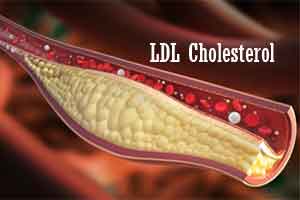- Home
- Editorial
- News
- Practice Guidelines
- Anesthesiology Guidelines
- Cancer Guidelines
- Cardiac Sciences Guidelines
- Critical Care Guidelines
- Dentistry Guidelines
- Dermatology Guidelines
- Diabetes and Endo Guidelines
- Diagnostics Guidelines
- ENT Guidelines
- Featured Practice Guidelines
- Gastroenterology Guidelines
- Geriatrics Guidelines
- Medicine Guidelines
- Nephrology Guidelines
- Neurosciences Guidelines
- Obs and Gynae Guidelines
- Ophthalmology Guidelines
- Orthopaedics Guidelines
- Paediatrics Guidelines
- Psychiatry Guidelines
- Pulmonology Guidelines
- Radiology Guidelines
- Surgery Guidelines
- Urology Guidelines
High LDL Cholesterol increases risk of PAD and CKD and not retinopathy and neuropathy: JACC study

High levels of low-density lipoprotein cholesterol increase the risk of peripheral arterial disease (PAD) and chronic kidney disease (CKD) but do not increase the risk for retinopathy and neuropathy,finds a new study. The study has appeared in the Journal of the American College of Cardiology.
Macrovascular disease results from atheromatous changes in large and medium-sized blood vessels that may become partly or totally blocked. The resulting impairment can affect the cardiovascular system leading to angina and coronary thrombosis, the cerebrovascular system causing stroke, and the peripheral arterial disease causing claudication and tissue damage.
Low-density lipoprotein cholesterol (LDL-C) is causally associated with a high risk of coronary artery disease. Whether high LDL-C causally relates to the risk of retinopathy, neuropathy, chronic kidney disease (CKD), and peripheral arterial disease (PAD) in the general population is not known. Dr Frida Emanuelsson and colleagues conducted the study to determine the same.
The researchers performed one-sample Mendelian randomization (MR) of 116,419 Danish individuals, 2-sample MR on summary-level data from the Global Lipid Genetics Consortium (GLGC) and the UK Biobank, and meta-analysis of randomized statin trials.
Observationally, high low-density lipoprotein cholesterol did not associate with a high risk of retinopathy or neuropathy. There were stepwise increases in risk of chronic kidney disease and peripheral arterial disease with higher LDL-C, with hazard ratios of 1.05 (95% confidence interval [CI]: 0.97 to 1.13) for CKD, and 1.41 (95% CI: 1.23 to 1.62) for PAD in individuals with LDL-C above the 95th percentile versus below the 50th percentile.
In genetic, causal analyses in the Copenhagen studies, the risk ratio of disease for a 1 mmol/l higher LDL-C was 1.06 (95% CI: 0.24 to 4.58) for retinopathy, 1.05 (95% CI: 0.64 to 1.72) for neuropathy, 3.83 (95% CI: 2.00 to 7.34) for CKD, and 2.09 (95% CI: 1.30 to 2.38) for PAD. Summary-level data from the GLGC and the UK Biobank for retinopathy, neuropathy, and PAD gave similar results. For CKD, a 1-mmol/l lower LDL-C conferred a higher eGFR of 1.95 ml/min/1.73 m2 (95% CI: 1.88 to 2.02 ml/min/1.73 m2) observationally, 5.92 ml/min/1.73 m2 (95% CI: 4.97 to 6.86 ml/min/1.73 m2) genetically, and 2.69 ml/min/1.73 m2 (95% CI: 1.48 to 3.94 ml/min/1.73 m2) through statin therapy.
The researchers concluded that high levels of low-density lipoprotein cholesterol was not causally associated with risk of retinopathy and neuropathy; however, high LDL-C was observationally and genetically associated with high risks of PAD and CKD, suggesting that LDL-C is causally involved in the pathogenesis of these diseases.
Dr Prem Aggarwal, (MD, DNB Medicine, DNB Cardiology) is a Cardiologist by profession and also the Co-founder of Medical Dialogues. He is the Chairman of Sanjeevan Hospital in Central Delhi and also serving as the member of Delhi Medical Council

Disclaimer: This site is primarily intended for healthcare professionals. Any content/information on this website does not replace the advice of medical and/or health professionals and should not be construed as medical/diagnostic advice/endorsement or prescription. Use of this site is subject to our terms of use, privacy policy, advertisement policy. © 2020 Minerva Medical Treatment Pvt Ltd